- Details
- Hits: 1816
HOW TO FIND A REPUTABLE BREEDER
By: Judith Schulz
People have asked me over the years what to look for when buying a Maine Coon kitten. With so much contradicting information out there, an intensive search can become confusing and frustrating! This is why I added another link to my website:
What can be some of the signs of a good breeder?
There are as many responsible as irresponsible breeders out there. Showing discernment is the key! Breeders certainly don't have to meet all the criteria below to be reputable! I am simply trying to give people some "clues" on what to look for:
- The breeder is at least registered with one registry CRUCIAL or several Associations DESIRABLE (preferably with MCBFA also if an older Cattery). MCBFA has ceased and membership had to be earned.
- Breeder regularly tests for breed-specific diseases (HCM, PKD, HD, also SMA in some lines) CRUCIAL
Both the gene test and Color Doppler Echo Cardiogram are tools for HCM testing. However, the Color Doppler Echocardiogram/Ultrasound, done by a heart specialist, is presently the only fairly reliable form of HCM testing. The older the animal is at time of testing, the better. Oh, and yes, there can definitely be hip and heart problems in ALL pedigrees of the Maine Coon breed.
- Breeder shows his/her cats regularly or has past show experience. CRUCIAL to be able to breed according to standard.
- Facility pictures are openly shown on the homepage DESIRABLE
- Pictures and some information about the breeder and his/her family is DESIRABLE as you might want to see and know about whom you are potentially getting your kitten/cat from.
- Some of the pictures of kittens/cats on a homepage show the background ( the actual living space) DESIRABLE
- Breeder openly displays registered names and pedigrees of his/her cats on the homepage, not just the "call names "DESIRABLE as this can protect you from fraud.
- Cats are not kept in pens, except for birthing, introduction purposes, or possibly short periods for a potentially spraying tom cat CRUCIAL
- The facility is not overpopulated CRUCIAL for health and well being. Crowding leads to stress, stress often leads to disease. Overpopulated Catteries will not be able to pass TICA Cattery of Excellence with a good rating.
- Breeder lets you see their facility by appointment (or during pick-up of our kitten) DESIRABLE but please take into consideration that some breeders will not let you visit to protect their Cattery from viruses and diseases.
- Health and hygiene in the facility are excellent CRUCIAL
- The majority of cats are friendly and outgoing CRUCIAL. If they aren’t they could possibly breed with shy bloodlines or don’t socialize their cats.
- Breeder’s concern is to provide a healthy, quality kitten, rather than following trends and extremes. CRUCIAL
- The breeder has good communication skills. How do you expect to get proper after-care if communication is not satisfactory before the purchase? DESIRABLE
- The facility is Veterinary inspected DESIRABLE. Definitely! Why not?
- Breeder takes part in a voluntary responsible breeding program (CFA and TICA offer these) DESIRABLE
- Kittens and cats appear healthy, with nice coats, clear eyes/noses and well-nourished CRUCIAL
- The breeder is transparent about potential problems or weaknesses in certain lines. Purebred doesn't mean perfect. Beware of "disease-free or "free of genetic defects" catteries! Even though some breeders are able to produce *very* healthy kittens on a continuous basis, you likely aren't being told the truth if everything sounds just a little too perfect. CRUCIAL
- Matings are being done wisely, with a keen knowledge of pedigrees, heterozygosity and potential issues in the lines. CRUCIAL!
- The breeder has a responsible, somewhat outcrossed program in place (note: an "unrelated" pedigree over 4 generations can in reality be very inbred!!) CRUCIAL. Too much inbreeding lowers immunity and produces irritability in temperament.
- Breeder makes a supplemented Raw meat mix part of the cats'/kittens' diet (if commercial food is fed additionally, it is grain/gluten/corn free). Believe it or not, this could potentially be CRUCIAL as it gives your kittens a great start in life.
- Breeder has a controlled amount of litters throughout the year and enough loving homes lined up for the kittens. CRUCIAL
- Breeder has experience,visible knowledge about his breed and also a real love and passion for the breed and his/her own cats CRUCIAL
- Kittens are checked by a veterinarian before they leave the breeder CRUCIAL
- Breeder wants to get to know prospective buyer before selling a kitten CRUCIAL
- Breeder does early spaying/neutering or requires spaying/neutering before releasing the registration papers CRUCIAL
- Breeder has a written sales contract and health guarantee, asking you not to declaw the kitten or let the kitten go outside without supervision CRUCIAL
- Kittens are sold with registration papers, once proof of sterilization has taken place CRUCIAL
- Kittens are not released to their new homes before at least 12 weeks of age CRUCIAL
- Breeder never sells to pet stores CRUCIAL
- Breeder never sells to strangers out of a cage or out of their car at a cat show CRUCIAL
- Breeder is able to provide excellent references. CRUCIAL
- Breeder does not give cheap "deals' on a continuous basis. Proper quality care would not allow an unusually low price. Chances are you pay for what you get or it’s a scammer. CRUCIAL
- Breeder has at least a decade of breeding experience or is supervised by excellent mentors CRUCIAL
Don't be fooled - backyard breeders and kitten mills can have very appealing webpages. They can be professionals in taking amazing, often heavily photoshopped and manipulated kitten pictures. You might never know who the parents really are. Some cats in the pedigree may have been tested * somewhat* for genetic problems but has the breeder him/herself lifted any finger to get their own breeding stock *properly* tested? The same goes with titles - let them show off those ribbons :-).
Some newer breeders here in Canada have a heart of gold, a TRUE passion for our breed, a longing to be mentored and to do things properly. Blessings to them!
Having said this, MANY so called breeders are suddenly coming out of the wood works, recognizing a market niche, due to the latest developments of the pet industry. They often aim for expensive “rave colours” and overtypification, have no proper mentoring and literally are a disgrace to our beloved breed! Many other breeds of cats and dogs have been ruined by their kind.
Then there are scammers. Scammers steel pictures off of other websites and sometimes don’t even have cats! They can potentially take your money and run!
Long story short, just make sure to ask LOTS of questions before committing to a purchase.
There are further things to consider when buying a Maine Coon kitten, but this list above gives you a pretty good indication about some important details. Some of us have learnt to read between the lines when looking at webpages. Please do your homework before buying a kitten from a questionable place!
Oh and by the way..........There is an enormous difference between animal welfare organizations, which work for the humane treatment of animals, and animal rights organizations, which aim to completely end the use and ownership of animals. Just type in “the truth about peta” in your search engine and learn about them. Here’s a good one:
https://www.youtube.com/watch?v=ya4G2At_oLM
By: Judith Schulz
- Details
- Hits: 1795
This checklist can also be used for other breeds with some adaptation as, for example, not all breeds test for HD.
There will be a majority who wonder, why on earth should I have a checklist, I will only buy a companion cat that will be our new family member, not an kitten for exhibition or to breed, why is it so important to check all those things?
Buying a purebred costs money, a lot of money, how many of you would go out and buy a car without seeing inspection paper or number of miles driven?
Even if you are only going to have the car to go shopping and drive around in for work, you will probably check both reliability and number of miles, if it got any dots on the inspection, how well serviced it is, or ???
Why in the world would you NOT do the same thing to a living being, a family member?
Do not agree to pay for a place in a queue for a kitten, this is something that is a lot more common outside Scandinavia and northern Europe, there are many breeders who do not charge for you to stand in line with them, contact one of these instead.
Do not agree to pay anything before the kitten is born! This does not occur in principle in Scandinavia but seems to be more common on other continents, preferably you pay deposit after visiting when the kitten are at least 4 weeks old.
Check out the pedigree of both parents and the offspring, of course the cat you buy must be registered in an association or Indenpendent club.
Require to see that HD test has been done on the parents within PawPeds, this can be seen online, via OFA the breeder has a paper that you can see.
Require to see that HCM is done on the parents, these are done before the first mating, then approximately annually up to 3 years and then once at 5 years of age.
Approximately this is done at 1, 2, 3 and 5 years of age. Sometimes it might be a gap, but the parents should not be 5 years old, and tested at 1 year of age and nothing after that.
DO NOT pay an overprice for a color, no color is unusual enough to justify an overprice even if some breeders want you to believe this. Feel free to check what the price for a company kitten, is in your particular country, it might vary a bit of course but not to the extreme.
There are lots of good breeders in your own country, DO NOT start by Importing, this is for breeders with experience and knowledge!
Seemingly lower prices might attract but in the end it often becomes an expensive lesson learned.
Buy a kitten close enough to be able to visit and meet the breeder and your future new family member, if a meeting is absolutely not possible due to distance or otherwise, a video chat with the breeder can be made, where you can see the kitten live and get to know the breeder. If you can not visit, make sure you go to the breeder's house to pick up your new family member.
The kittens should be clean and nice, clear eyes, clean ears, no signs of diarrhea or the like. Ask to see the mother, preferably the father if possible, to see what they look like and how they seem to be in the temperament.
No kitten may be delivered before 12 weeks of age, according to the Animal Welfare laws here!
If they are 13-16 weeks, it is only an advantage.
Not all countries have an animal welfare law that says 12 weeks, this does not mean that you as the buyer must agree that the kitten is delivered before 12 weeks, they need to be with their mother for at least 12 weeks.
- Details
- Hits: 4427
OMG! That's a Huge Maine Coon
The Maine Coon has taken the internet by storm, fascinating cat lovers all over the world with its beauty, size, and majestic presence. The demand for such a "big" cat has become increasingly overwhelming.
The Maine Coon cat is the largest breed of a domesticated cat. When fully mature, the average size of a male is 18-22 pounds and 9-13 pounds for a female. Just like people, their shapes and sizes can fall outside of the "average".
While most of my males fall in the average range, I do have one that is way beyond that, weighing in at 29 pounds at 3 years old. (Omega, my solid white Maine Coon). In person, he seems like a mythical creature being the size he is.
Omega isn't the most agile cat. He doesn't jump much and when he does, he's very awkward and clumsy. I'm pretty sure that it's due to his size and weight. It's a lot for him to carry around. I keep a close eye on his heart health and his joint health because of his size. He has sprained his elbow from simply jumping off the cat tree!
As a kitten, there was no way for the breeder, me, or anyone to be able to predict how large he would be. He was the same size as his littermates. In fact, my daughter has his brother and he's 19 pounds.
Educating yourself about what to expect when you buy a Maine Coon kitten is the best thing that you can do. If you're interested in this breed for its mere size, then you're truly missing out on so many other fascinating qualities that they exhibit.
Don't Always Believe What You See on The Internet
What you're about to see might shock you. While it's true that Maine Coons are large cats, the photographs of them can be manipulated in a way to make them seem enormous! For the ordinary person that isn't familiar with this "photography" trick, you're about to discover something new.
The closer something is the camera lens, in comparison with objects int the background, the bigger it appears in the photograph. So you'll see people holding their Maine Coons in a photograph and the cat looks super big! In reality, the cat may be of average size and weight. The appearance is made through the camera lens.
I took some photographs of 3 of my own cats, all of the different sizes to show you just how crazy it is to see them side by side. In the first photo, I am holding the cat close to my body. In the second photo, I'm holding the cat with my arms extended outward, thus moving the cat closer to the camera lens.
It wasn't easy to hold Omega out like that, but I managed to do it! I counted it as my workout for the day.
Joan - 4 Pound Maine Coon Kitten
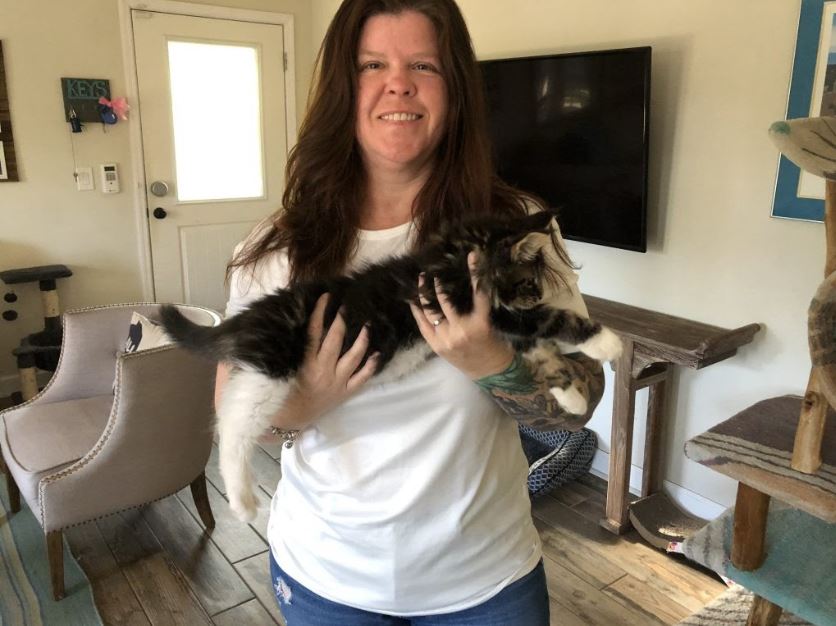
Joan - 3 months old - 4 Pounds ( 1,81 Kg)
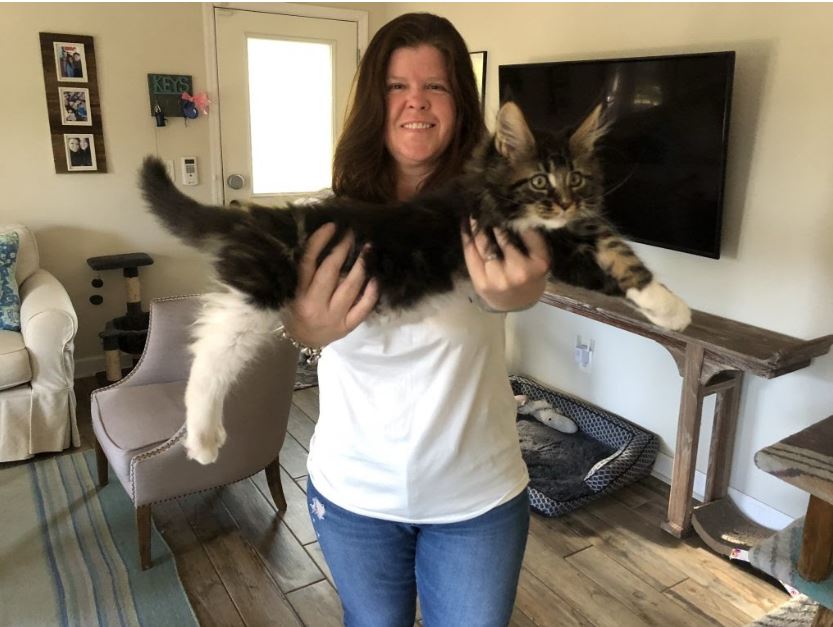
Joan - 3 months old - 4 pounds (1.81 kg)
Finlay - 19 pound Maine Coon
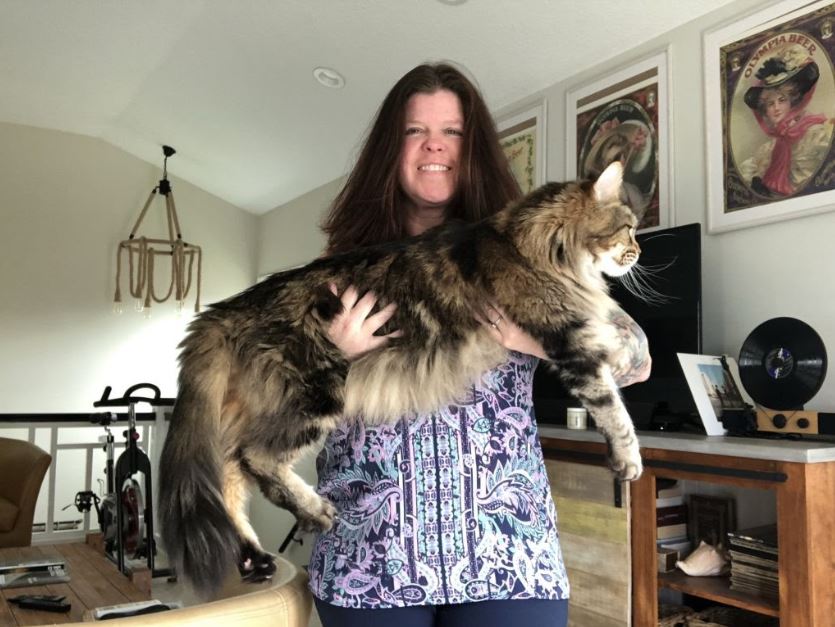
Finlay - 6 years old - 19 pounds (8,62 kg)
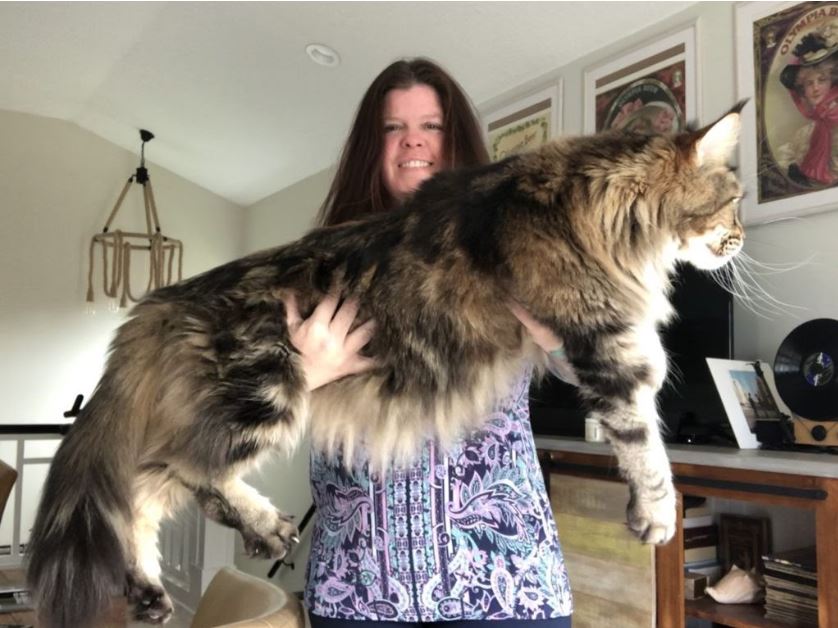
Finlay - 6 years old - 19 pounds (8,62 Kg)
Omega - 29 pound Maine Coon
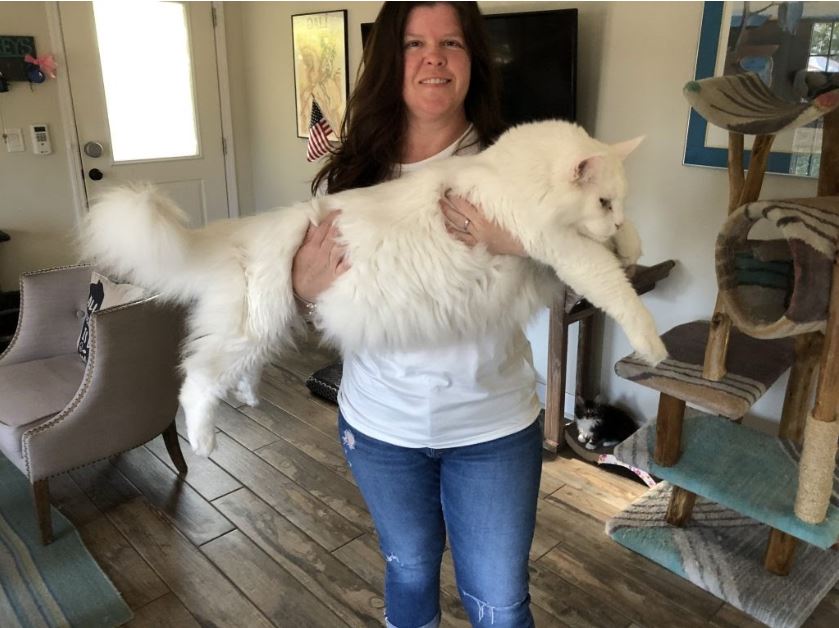
Omega- 3 Years old - 29 pounds (13.15 Kg)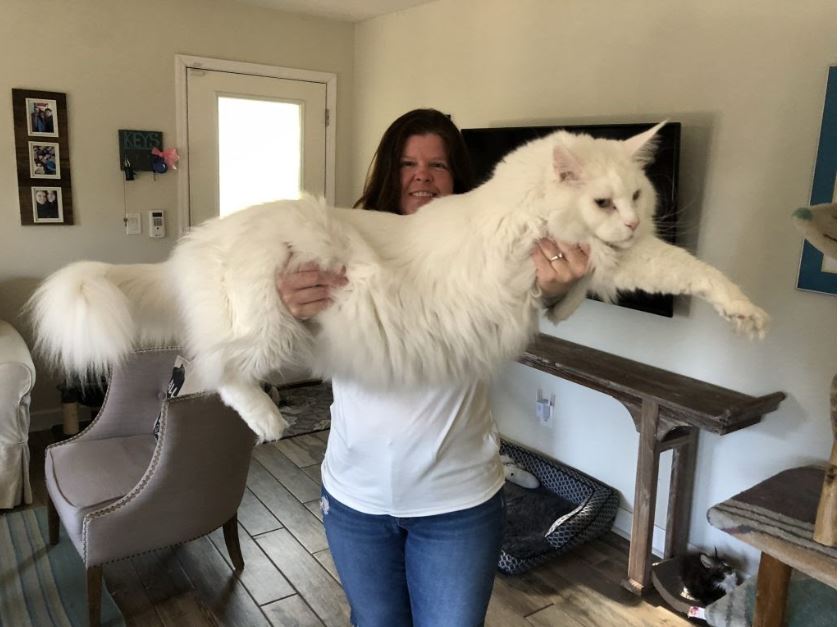
<
Omega- 3 Years old - 29 pounds (13.15 Kg)
OK well, Omega looks huge any way you look at him. LOL
You Know What They Say...It's Not the Size of the Boat
As always, I like to educate the public about Maine Coons and the topics that surround them. The point of this blog post was to bring awareness to the perception of giant Maine Coons from photographs online.
Personally, I refuse to sell a kitten to anyone who makes the size of their cat a priority. Since there's no way for me to predict how the kitten will turn out once it's fully mature, I don't want to leave anyone disappointed.
I prefer to keep my focus on health, temperament, and meeting the Maine Coon breed standard. I think those three areas are the most important. You may also want to find a Maine Coon breeder that puts health and temperament first.
Maine Coon Breed Standard
The Maine Coon breed Standard is shown in the photographs below. There's no mention of any particular size or weight.
If you're looking for the "biggest cat you can find" or a "giant Maine Coon", then you may want to consider a retiree. This way you can already see what they will look like as an adult. Otherwise, take the time to learn more about the Maine Coon other than it's size. It's full of so many wonderful characteristics.
By: Sassy Koonz
- Details
- Hits: 3560
It seems to be going on an explosion of cats sold as purebred but without pedigree (without registration), I have talked to so, so many who bought those cats.
I just can’t stop wondering about what makes people buy a cat without pedigree just to save maybe 1000-1500 SEK (about 100-150 Euro or 105-158 Dollar)?
The only thing I could come up with is that you live in the belief that the pedigree is just a piece of paper, on which the shows relatives.
This couldn’t be more wrong it should rather be compared to some form of qualitystamp, of course there will be exceptions, I’m not in any way says that you without any reservation should go out and by just about any cat, without further examination. of the breeder just because the cat got a pedigree and are registered, absolutely not. But a pedigree says so much more then just the names of the relatives and their registration-numbers.
I will try to write down some good things a pedigree can tell you. Some of this below can be a bit different from country to country, I will write what goes for sweden mainly since thats what I know.
- The breeder is a member of an association and is obligated to follow their rules (in sweden and some other countries also the board of agricultural).
- Both parents is registered in a studbook.
- Both parents need a certificat that they are free from hernia. (Sweden)
- The father must have a certificat that he is not kryptochid, this can be done as earliest at 6 month of age.
- Kittens must be Id-marked with chip. (Sweden)
- Kittens must be vaccinated twice (Sweden)
- They are not allowed to be sold without a health certificate which cannot be older then 7 days.
- The breeder are not allowed to let the female have more then 3 litters in 2 years.
- The kittens are not allowed to leave their mother before they turned 12 weeks old, not a day earlier.
- No kittens are allowed to be withheld registration.
- A breeder who is a member of an association is not allowed to contribute to breeding housecats in any way. Not offer studservice, let a houscat have a litter, not do any mixed breeding.
- To breed to another breed a breeder need to apply for control-breeding, and will then get a pedigree for the kittens.
- A breeder who happen to get a accident-breeding (a female is sneaking out and are mated to a housecat or two breeds in the same home accidently mate, still need to register the litter with a “housecat proof” and report the misstake to it’s association.
- Most breeders do follow the health program for the breed, you can read about what a health program is on www.pawpeds.com or in the article on this page.
A breeder who is caught cheating with a pedigree, or in anyway missbehave will be suspended from the association and can then no longer reigster their kittens. Keep this in mind when you buy a not registred mixed breed or purebred, this can be a breeder who misbehaved and been suspended. Is this someone you want to trust your money?
Through the pedigree you can get help at the association if questions aries and you can follow the generations back and get a lot of information about as well health as other herited factors who might be present behind your kitten.
This is just a few of all that comes with a pedigree, as you can see a pedigree is a lot more then just a piece of paper.
Everyone who whish can a member of an association, in some associations 1 litter are allowed to be registred whitout a catteryname. So as you all can see, if everything is in order, there is really nothing in the way for register the litter.
The costs are not high eighter.
Membership is about 200-350 SEK/Year.
Catteryname is about 750-1500 SEK (this is something that pays just once).
Registration is about 200-350 SEK/Per Kitten.
By: Malin Sundqvist
- Details
- Hits: 2436
I have countless times in recent years, probably since all way back to just a few years after they released the requirement that the cats imported to Sweden need to be titer tested for rabies or admitted on dispensation before 3 months of age. When they changed the rules so that we only need to get rabies vaccine and then wait for 21 days to take the cat into Sweden, it became a LOT easier for us, though this requires that you travel to the country where the cat is and pick up the cat yourself, if someone else will bring the cat to Sweden for you a trace certificate is required, this is quite expensive and tediously to obtain. (unreasonable if you ask me, but such are the rules).
Well, it was not the different ways of import I wanted to talk about, although this is actually more than relevant in this case as countless breeders from the eastern countries are more than happy to send the cat with a person to the appropriate airport and hand over the cat to you there, and this is actually not allowed without a traces, the cat will count as smuggled in, and it seems like most new breeders do not even know about this.
Buying a cat with breeding rights in Sweden (and as far as I understood, the same goes mainly for all other countries in the world), is not easy, but I can honestly say that I have actually received very few requests! But even if they all would have been asking me, it would just not have been possible for me to sell kittens with breeding rights to everyone who seems to be searching for a kitten to use for breeding. However, it’s not as difficult as it may seem, I have talked to lots of friends who also breed, and everyone I do know, seems to have the same attitude as me, they are by no means averse to selling kittens for breeding to a new breeder, on the contrary!
However, as well as most of my friends, I want a proper presentation, we want to know that you have thought this through really well and that you have a goal for your breeding (here I think, I can speak for both show-breeders and outcross-breeders, we want you to have a registered cattery when looking for the kitten, or at least have one before it's time for the kitten to move in). We want you to have a plan and a goal, a thought regarding your breeding, of course, the one who will sell the kitten to you wants your goal to be in good agreement with the goal he or she has. Your breeder should be your mentor and then it is good if you have a similar view on breeding. Talk to breeders well in advance, and create a relationship with breeders, this will make your way to a new kitten for breeding so much easier, and not just that first one, but also all the future breeding cats. A breeder who knows you well will gladly be your mentor and vouch for you to other breeders.
Let’s talk about the big question, to import, maybe mainly from the eastern countries (please be aware that there are a lot of good breeders there also, not all are bad).
What makes imports from those countries so attractive? I can see that it’s not just in Sweden this happens I see it all over the world. And what risks does this involve?
- Many, many breeders ask no questions or very few questions at all, is this good or bad? I wouldn’t say, it’s a good sign when the breeder doesn’t ask questions. Instead, they just more or less sell the cat straight to you.
You could ask yourself how many more cats with the same pedigree did this breeder already sold, to the same country, countries close by, or just sold with breeding rights? - Within some countries, there is an enormous mass of so-called. Cat factories that just mass-produce kittens.
The groups of cats are extremely large and many times there is not a fraction of all the cats present for you to see on the websites.
The cats live in special buildings and the rules are far from our strict rules (now I’m thinking about Sweden, other countries might not have the same strict rules we have regarding the animals). With this, other problems arise. (Of course, not all breeders from those countries are like this, there are a lot of good breeders, but as a new breeder on the way to start up, or a new breeder who just started, how would you know what to look for?).- Infection pressure, in such a large group of cats, will become enormous. The risks increase significantly for your new cat to have an outbreak of infections, such as herpes, chlamydia, mycoplasma, high titers on corona, giardia, tri trichomonas, or cryptosporidium, just to make a few examples. Your cat's immune system will be out from the beginning because of stress and you might have to deal with a cat sick from the trip the first thing you do. (Please do observe that 80% of all cats worldwide do carry the Feline Herpes virus, more or less every single cat in a household of more than 2 cats breeder or pet owner will have corona, Mycoplasma felis is normal in a cat body, if a cat gets symptoms it's often a sign of another type of infection read more about those in the health section).
- There is also a big risk that your new cat or kitten is very untrained socially and very shy if it as a kitten has grown up more or less isolated from human contact.
- Another thing that might be good to know, especially in some countries, is that you can get just about anything if you just pay, corruption is very common. This means that if you ask the breeder for tests they can basically go to a veterinarian and just buy themselves a certificate (of course,e not all veterinarians are like this but, it's pretty common in some countries). The same goes for the certificate of course that the cat is free from infections. (This is told by good breeders from those countries, so it comes from reliable sources).
- The parents are almost never tested for HD and HCM other than through DNA, this can also apply to other actually good breeders, but if you are going to import a cat or kitten for a lot of money who is also from not tested parents, then you should at least make sure that the cat/kitten you will import got a really unique pedigree. How would you know what’s unique if you do not know all the cattery names and the history of those back in a pedigree?
- You should also be aware that a breeder in some countries does not even take one-third as much for a cat in their own country as they do when exporting a cat. For them, it’s a hugely good deal to sell a cat abroad. This, unfortunately, attracts a great deal of anything but serious people who want to earn big money on the mass export of cats. Some have even built up a business with the decoy in Sweden or possibly other countries as well, a relative or friend living in the country in question, who sells the cats for them.
- I have seen countless times on various international forums where breeders paid in advance just to never receive any kitten.
- I also have seen and talked to many, many breeders who bought cats or kittens who have been really, really sick at arrival, in worse cases even died soon after arrival.
- An import should also have unique lines, otherwise, it is quite pointless to bring the cat or kitten to our country, right?
To import is an adventure even for an old experienced breeder, so wait to import a cat/kitten until you have some experience. If you would like to try this as a new breeder, please make sure you have a very experienced breeder who helps you, a breeder with many contacts abroad who can help you find a good breeder that they know, or know someone who knows, etc.
It’s been countless times over the years when I have seen various cases where things went very wrong because someone has done an import without having the knowledge.
I’ve seen imports from Australia/New Zealand/USA, being imported to Sweden and claimed to be very unique lines. I threw a single look at the pedigree and found out that, the grandmother of the cat was actually born at my friend's cattery, close by in Sweden, the same thing with the father's side in the pedigree, even though there was perfect known cats from the Nordic countries, together with a few so-called. Dozen lines, ie cats found in each and every pedigree. When importing it’s not a fact that if it’s further away it’s more unrelated lines (apart from the US) most of the countries far away from Sweden actually got mostly imports from Europe themselves. So don't cross the river for water. In this case, it would actually be a lot less expensive and a lot easier to just travel 1 hour to get a cat/kitten with those lines and then import from the other side of the world.
Another case I have seen was a male represented as completely unique, purchased from "some" country in Europe and imported to Sweden. In this case, the male already had a brother who was already imported and bred in Sweden, just about a 1-hour drive from where this new male was located.
Now, I am not saying that it is WRONG to find cats that are related and import to the same country, I have done it as well as others, but we should not fool ourselves into thinking that what we take in is unique when it’s not. Learn to read and recognize both cat and cattery names before deciding to import. Learn to be able to recognize names in pedigrees. So that you know what it is you bring in, so you how much or how little the cat/kitten you bring into the country actually is.
A tip that I always advise is to make test matings, with all imported cats you can remember in our country, (here it definitely helps if you have been breeding for a while or if you have an experienced mentor who’s been doing this a little longer). I found a boy a while ago, unfortunately, one of the parents had HD, so I could not buy him but, what a pedigree! I did test mating with all the cats I could come up with here in Sweden, both imports and Swedish-born, females and males, show lines as outcross-lines, and the absolute closest I came in inbreeding was 0.07% in 8 generations… (of course also low in clones), It was a really unique line for Sweden, but unfortunately, things do not always go as we want, so I just keep looking and hope to stumble upon something equally unique but this time with all the qualifications I personally wish for.
Finally, I just want to point out that of course there are good breeders in the eastern countries, just as there are ridiculously bad breeders also in the rest of the world. So the main advice is really to wait with imports until you get a bit more experience or to ask for help from some very experienced breeder.
By: Malin Sundqvist










